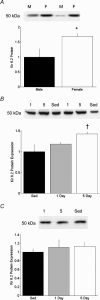Susceptibility of the heart to ischaemia-reperfusion injury and exercise-induced cardioprotection are sex-dependent in the rat
- PMID: 15718263
- PMCID: PMC1464442
- DOI: 10.1113/jphysiol.2004.081323
Susceptibility of the heart to ischaemia-reperfusion injury and exercise-induced cardioprotection are sex-dependent in the rat
Abstract
The cardioprotective effects of short-term exercise against myocardial ischaemia-reperfusion injury in male and female rats were examined. We subjected male and female rats to 0 (Sed; n = 8 males and 8 females), 1 (1 day; n = 10 males and 8 females), or 5 (5 day; n = 6 males and 6 females) days of treadmill running. Langendorff-perfused hearts underwent 1 h of regional ischaemia and 2 h of reperfusion, and infarct size (expressed as a percentage of the zone at risk; ZAR), left ventricular pressure development, and coronary flow were measured for each heart. Preischaemic pressure development and coronary flow did not differ between the sexes nor were they influenced by exercise. Sed females had significantly smaller infarct sizes (25 +/- 3%) than Sed male hearts (37 +/- 3%; P < 0.001). Short-term running significantly reduced infarct size following 1 day (27 +/- 3%; P < 0.05) and 5 days (30 +/- 4%; P < 0.10) of exercise in males. One day of running did not reduce infarct size in females (19 +/- 3%; P = NS), but 5 day females did show a significant reduction in infarct size (13 +/- 2%; P < 0.05). There was no relationship between postischaemic coronary vascular hyperaemia and infarct size across sexes or exercise training groups. Hearts from Sed females exhibited significantly higher manganese superoxide dismutase (MnSOD) protein expression than hearts from Sed males, but short-term exercise (neither 1 nor 5 days) did not alter MnSOD protein in either sex. Increased sarcolemmal ATP-sensitive K(+) (K(ATP)) channel subunit protein expression (SUR2A and/or K(ir)6.2) correlated closely with sex-dependent and exercise-acquired protection against myocardial infarction. These data indicate that: (1) sex-dependent and exercise-induced differences in the susceptibility of the heart to ischaemia-reperfusion injury are not associated with improved coronary flow or postischaemic hyperaemia; (2) increased MnSOD protein expression is not necessary for exercise-induced protection from infarction; and (3) one possible mechanism for sex-dependent and exercise-mediated reductions in infarct size involves an increased protein expression of cardiac sarcolemmal K(ATP) channels.
Figures





References
-
- Barp J, Araujo AS, Fernandes TR, Rigatto KV, Llesuy S, Bello-Klein A, et al. Myocardial antioxidant and oxidative stress changes due to sex hormones. Braz J Med Biol Res. 2002;35:1075–1081. - PubMed
-
- Bolli R. The late phase of preconditioning. Circ Res. 2000;87:972–983. - PubMed
-
- Bowles DK, Farrar RP, Starnes JW. Exercise training improves cardiac function after ischemia in the isolated, working rat heart. Am J Physiol. 1992;263:H804–H809. - PubMed
-
- Bowles DK, Starnes JW. Exercise training improves metabolic response after ischemia in isolated working rat heart. J Appl Physiol. 1994;76:1608–1614. - PubMed
-
- Brandes RP, Mugge A. Gender differences in the generation of superoxide anions in the rat aorta. Life Sci. 1997;60:391–396. - PubMed
Publication types
MeSH terms
Substances
Grants and funding
LinkOut - more resources
Full Text Sources
Other Literature Sources
Miscellaneous

